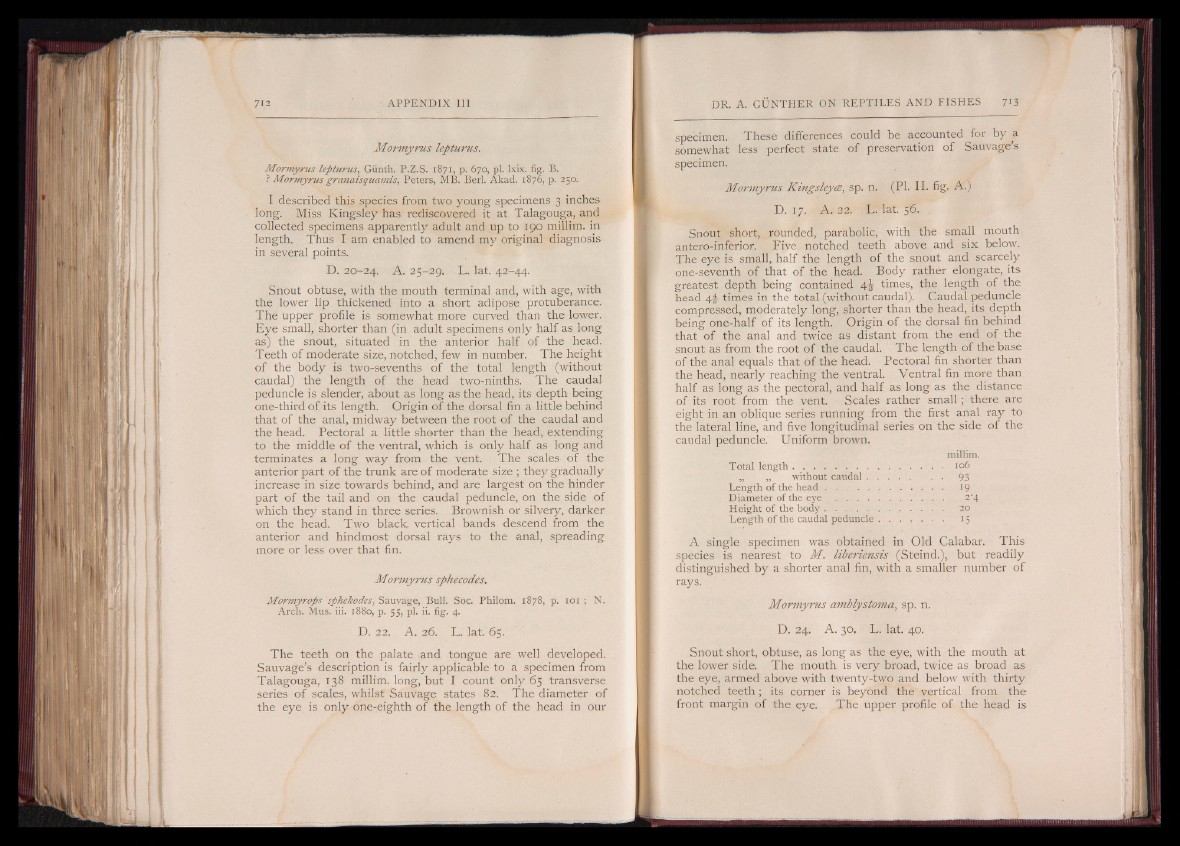
Mormyrus lepturus.
Mormyrus lepturus, Giinth. P.Z.S. 1871, p. 670, pi. lxix. fig. B.
? Mormyrus granaisquamis, Peters, MB. Berl. Akad. 1876, p. 250.
I described this species from two young specimens 3 inches
long. Miss Kingsley has rediscovered it at Talagouga, and
collected specimens apparently adult and up to 190 millim. in
length. Thus I am enabled to amend my original diagnosis
in several points.
D. 20-24. A. 25-29. L. lat. 42-44.
Snout obtuse, with the mouth terminal and, with age, with
the lower lip thickened into a short adipose protuberance.
The upper profile is somewhat more curved than the lower.
Eye small, shorter than (in adult specimens only half as long
as) the snout, situated in the anterior half of the head.
Teeth of moderate size, notched, few in number. The height
of the body is two-sevenths of the total length (without
caudal) the length of the head two-ninths. The caudal
peduncle is slender, about as long as the head, its depth being
one-third of its length. Origin of the dorsal fin a little behind
that of the anal, midway between the root of the caudal and
the head. Pectoral a little shorter than the head, extending
to the middle of the ventral, which is only half as long and
terminates a long way from the vent. The scales of the
anterior part of the trunk are of moderate size ; they gradually
increase in size towards behind, and are largest on the hinder
part of the tail and on the caudal peduncle, on the side of
which they stand in three series. Brownish or silvery, darker
on the head. Two black, vertical bands descend from the
anterior and hindmost dorsal rays to the anal, spreading
more or less over that fin.
Mormyrus sphecodes.
Mormyrops sphekodes, Sauvage, Bull. Soc. Philom. 1878, p. 101 ; N.
Arch. Mus. iii. 1880, p. 55, pi. ii. fig. 4.
D. 22. A. 26. L. lat. 65.
The teeth on the palate and tongue are well developed.
Sauvage’s description is fairly applicable to a specimen from
Talagouga, 138 millim. long, but I count only 65 transverse
series of scales, whilst Sauvage states 82. The diameter of
the eye is only one-eighth of the length of the head in our
specimen. These differences could be accounted for by a
somewhat less perfect state of preservation of Sauvage’s
specimen.
Mormyrus Kingsleyce, sp. n. (PI. II. fig. A.)
D. 17. A. 22. L. lat. 56. .
Snout short, rounded, parabolic, with the small mouth
antero-inferior. Five notched teeth above and six below.
The eye is small, half the length of the snout and scarcely
one-seventh of that of the head. Body rather elongate, its
greatest depth being contained 4h times, the length of the
head 44 times in the total (without caudal). Caudal peduncle
compressed, moderately long, shorter than the head, its depth
being one-half of its length. Origin of the dorsal fin behind
that of the anal and twice as distant from the end of the
snout as from the root of the caudal. The length of the base
of the anal equals that of the head. Pectoral fin shorter than
the head, nearly reaching the ventral. Ventral fin more than
half as long as the pectoral, and half as long as the distance
of its root from the vent. Scales rather small; there are
eight in an oblique series running from the first anal ray to
the lateral line, and five longitudinal series on the side of the
caudal peduncle. Uniform brown.
millim.
Total length.................... 106
„ „ without caudal.................. . . 93
Length of the h e a d ............................................ 19
Diameter of the e y e ................................. 2'4
Height of the b o d y ............................................. 20
Length of the caudal peduncle......................... 15
A single specimen was obtained in Old Calabar. This
species is nearest to M. liberiensis (Steind.), but readily
distinguished by a shorter anal fin, with a smaller number of
rays.
Mormyrus amblystoma, sp. n.
D. 24. A. 30. L. lat. 40.
Snout short, obtuse, as long as the eye, with the mouth at
the lower side. The mouth is very broad, twice as broad as
the eye, armed above with twenty-two and below with thirty
notched teeth; its corner is beyond the vertical from the
front margin of the eye. The upper profile of the head is